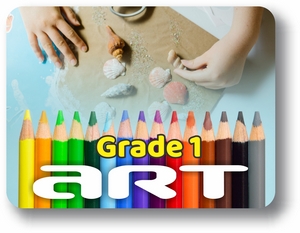Course Overview:
he Visual Art suite will provide students the foundational skills to be successful in a studio environment. Using the Elements of Art and Principles of Design as the framework, students will feel confident in creating their own style of art. Students will explore and use a variety of materials safely during the creative process. The courses explicitly teach art techniques through modeling and connecting them to master artists. During the creative process, students will apply art vocabulary, procedures, as well as time-management and collaborative skills. They will develop their observational skills, prior knowledge, and art critique skills to reflect on and interpret works of art. Throughout each multifaceted lesson, the students will make connections to art and various cultures around the world. The course offers rich text to support art history instruction, including information on artists and art movements over time. The Visual Art suite integrates standards from all the core subject areas, including Math, Social Studies, Science, Health, and Language Arts. Connections are made to Music, Dance, and Physical Education as well. The Visual Art suite will develop students fine motor skills, critical thinking skills, creativity, and their appreciation for global communities.
Required Materials:
Student-Supplied Resources:
- Printer
- Disk space on your computer as well as external device to back up your files (flash drive, external hard drive, CD–Rom, etc.)
- Cell phone to take photo of student's work or scanner to scan student's work
- Interactive Notebook (three-ring binder)
- Pencils
- Erasers
- Scissors
- Crayons and colored pencils
- Glue
- Tape
- Ruler
- Printer paper
- Multi-colored paper
Course Materials:
Along with your Student Supplied Resources, your “Art Kit” should include the following materials to use throughout the course. Be sure to check what you have and add materials as you need them while working through the course. Here is what you need to start building your Art Kit, many of these tools can be used more than once.
- 8 1⁄2 x 11 Sketchbook
- Markers
- Masking Tape
- Multi-colored paper or construction paper
- Cardstock or thick paper
- Tempera paint (various colors)
- Watercolor paints
- Paintbrushes (various sizes)
- Painting tools (paint pallet, water, paper towels, paint roller)
- Chalk pastels
- Oil pastels
- Charcoal
- Smock or old T-shirt
- Playdough or modeling clay
Module Specific Materials:
These are suggested materials that you can use for specific projects. Read this list carefully before going to the store, you probably have many of these materials already at home. You can start collecting recyclable materials, so you are ready for upcoming modules.
Module 1
- Photograph of yourself
- Music
- Thick black tape
Module 2
- Circle objects (lids, paper rolls, cups)
- Printmaking stamps (a variety of household objects)
- Painting tools (paper plates, water, paper towels...)
- Printmaking ink or acrylic craft paint
Module 3
- Painting tools (paint pallet, water, paper towels...)
- Watercolor paper or non-glossy Bristol board
- Raw canvas or a piece of light fabric
- Spray bottle
Module 4
- Various leaves found in nature
- Spray bottle
- Magazines, newspapers, or photos
Module 5
- Two different shoes
- Two traditional materials (can include tape, paint, torn paper, markers)
- Three non-traditional materials (can include plastic bags, water bottles, yarn, leaves, buttons, or sticks)
- Dice
- Magazines or newspapers
- Variety of textured objects
Module 6
- Small tiles or pieces of foam
- Beads
- A variety of recycled materials
Module 7
- Watercolor paper
- Painting tools (paint pallet, water, paper towels...)
- Two laminate sheets
- Black or colored permanent markers
- Popsicle stick
- A large piece of white paper
- Tracing paper
- Foam plate
- Printmaking ink (optional)
- Wooden spoon
- A variety of objects from nature (leaf, stone, flower, or plant)
- Recycled brown paper bag
- Sidewalk chalk
- Sandpaper (smooth works best)
- Colorful cloth or colored paper
- Old magazines, books, newspapers, or pamphlets
Free Downloads:
- Java
- Windows Media Player
- Apple iTunes
Syllabus:
Module 01: Line
- 01.02 Piet Mondrian
- 01.03 Module One Review And Assessment
Module 02: Shape
- 02.00 Module Two Pretest
- 02.01 Shape
- 02.02 Jessica Dismorr
- 02.03 Module Two Review And Assessment
- 02.04 Module Two Discussion-Based Assessment
Module 03: Color
- 03.00 Module Three Pretest
- 03.01 Color
- 03.02 Helen Frankenthaler
- 03.03 Module Three Review And Assessment
Module 04: Space
- 04.00 Module Four Pretest
- 04.01 Space
- 04.02 Romero Britto
- 04.03 Module Four Review And Assessment
- 04.04 Module Two Discussion-Based Assessment
Module 05: Texture
- 05.00 Module Five Pretest
- 05.01 Texture
- 05.02 Vincent van Gogh
- 05.03 Module Five Review And Assessment
Module 06: Form
- 06.00 Module Six Pretest
- 06.01 Form
- 06.02 Niki de Saint Phalle
- 06.03 Module Six Review And Assessment
- 06.04 Module Six Discussion-Based Assessment
Module 07: Art Around the World
- 07.00 Module Seven Pretest
- 07.01 Australia
- 07.02 Asia
- 07.03 Europe
- 07.04 Africa
- 07.05 Central America
- 07.06 The Caribbean
- 07.07 Module Seven Review And Assessment
- 07.08 Module Seven Discussion-Based Assessment

